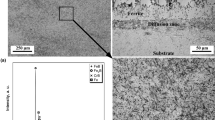This work aimed to analyze the properties of the experimental ABC100.30 powder material under friction on various structural steels without the use of a lubricant. Tribological tests were performed at constant load and sliding speed for various sliding distance values. The experiments revealed that the studied powder material had the best tribological properties when in contact with steel grade 20. In this case, the friction process was characterized by low values of volumetric and linear wear of the rubbing bodies, as well as a minimum average friction coefficient. The ABC100.30–steel grade 45 friction pair had the highest friction coefficient values and high linear and volumetric wear values. The friction process on steel 30HGSA was accompanied by the maximum wear of the investigated material; however, it was characterized by low friction coefficient values and minimum amplitude of fluctuations.






Similar content being viewed by others
References
Yu. G. Gurevich, V. N. Antsiferov, L. M. Savinykh, et al., Wear-Resistant Composite Materials [in Russian], UrO RAN, Yekaterinburg (2005).
A. Salak, Ferrous Powder Metallurgy, Cambridge International Science Publishing, Cambridge, UK (1997).
R. M. German, Sintering: From Empirical Observations to Scientific Principles, Butterworth-Heinemann, Oxford, UK (2014).
V. N. Antsiferov (editor), Problems of Modern Materials and Technologies [in Russian], Permskiy Gos. Tekh. Univ., Perm (1995).
R. M. German, Powder Metallurgy and Particulate Materials Processing: the Processes, Materials, Products, Properties, and Applications, Metal Powder Industries Federation, Princeton, New Jersey (2005).
F. S. Gobber, J. Bidulska, et al., “Innovative densification process of a Fe–Cr–C powder metallurgy steel,” Metals, 11 (665) (2021); https://doi.org/10.3390/met11040665.
R. V. Egorova and M. S. Egorov, Technology for Manufacturing Parts by Powder Metallurgy and Promising Materials Used in Additive Technologies [in Russian], Study Guide, DGTU, Rostov-on-Don (2020).
E. Robert-Perron, C. Blais, and S. Pelletier, “Tensile properties of sinter hardened powder metallurgy components machined in their green state,” Powder Metall., 52, No. 1, 80–83 (2009).
H. Kondo and M. Hegedus, “Current trends and challenges in the global aviation industry,” Acta Metall. Slovaca, 26, 141–143 (2020).
I. Chang and Y. Zhao, Automotive Applications of Powder Metallurgy, in book: Advanced in Powder Metallurgy, Woodhead Publishing Series, Cambridge, UK, 493–519 (2013).
M. S. Egorov, R. V. Egorova, V. N. Pustovoit, and A. A. Atrokhov, “Mechanical properties of powder materials after free sedimentation,” Metallurgist, No. 3, 92–96 (2020).
V. Yu. Dorofeev and S. N. Egorov, Interparticle Splicing in the Formation of Hot-Deformed Powder Materials [in Russian], Metallurgizdat, Moscow (2003).
M. S. Egorov and R. V. Egorova, “Relationship between mechanical properties and the nature of the fracture surface of powder steels under high-temperature tension,” Metallurg, No. 3, 73–81 (2021).
Tae-Hwan Lim, Chang-Soon Lee, et al., “Better surface integrity and tribological properties of steel sintered by powder metallurgy,” Materials, 13 (3172) (2020); https://doi.org/10.3390/ma13143172.
A. Mihailidis, C. Salpistis, et al., “Wear of machine elements made from powder metallurgical tool steels,” Tribol. Ind., 30, No. 1&2, 40–46 (2008).
ASTM G99-17, Standard Test Method for Wear Testing with a Pin-on-Disk Apparatus, ASTM International, West Conshohocken, PA (2017).
D. C. Montgomery, Design and Analysis of Experiments, John Wiley & Sons (2013).
E. Makarov, Engineering Calculations in MathCad 15 [in Russian], Piter, St. Petersburg (2011).
I. V. Kragelsky, Fundamentals of Calculations for Friction and Wear [in Russian], Mashinostroenie, Moscow (1977).
K. V. Frolov, Modern Tribology: Results and Prospects [in Russian], Izd-vo LKI, Moscow (2008).
Author information
Authors and Affiliations
Corresponding author
Additional information
Translated from Metallurg, Vol. 66, No. 1, pp. 60–64, January, 2022. Russian DOI https://doi.org/10.52351/00260827_2022_01_60.
Rights and permissions
About this article
Cite this article
Egorov, M.S., Egorova, R.V. & Fominov, E.V. Tribological Characteristics of ABC100.30 Alloys During Friction on Structural Steels Without Lubrication. Metallurgist 66, 71–77 (2022). https://doi.org/10.1007/s11015-022-01299-x
Received:
Published:
Issue Date:
DOI: https://doi.org/10.1007/s11015-022-01299-x




